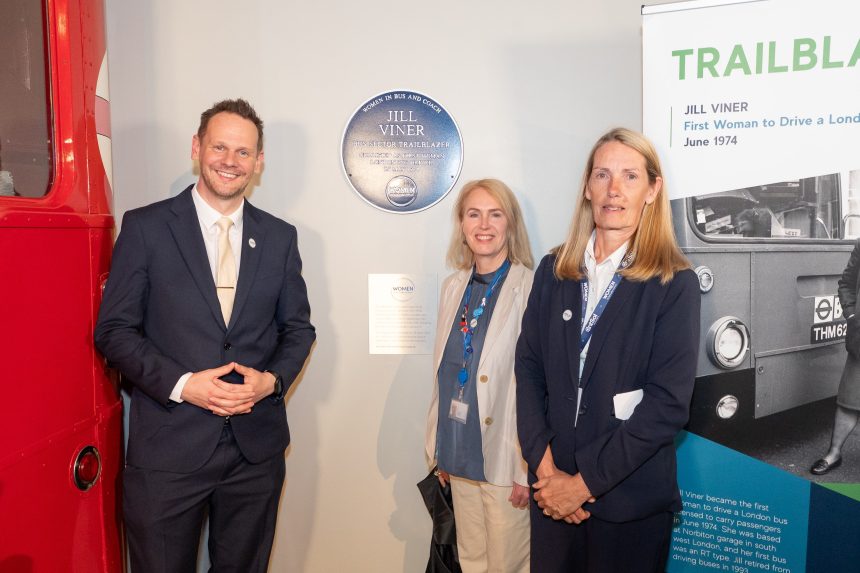The achievements of Jill Viner, who in 1974 became the first woman licensed to drive a London bus in passenger service, have been recognised with a new display at the London Transport Museum.
The blue plaque replica was unveiled at a recent event jointly hosted by the Museum and Women in Bus and Coach (WiBC).
The original plaque was installed in December 2024 at Kingston’s revamped Cromwell Road bus station, where route 65 — one of Jill’s first driven routes — still operates. The new museum exhibit aims to preserve Jill’s legacy and inspire future generations.
Organisers say the plaque marks a step in recognising the contributions of women in coach, bus and community transport, and preserving their stories for future generations.
The event also saw the announcement of two new WiBC ambassadors: Transport for London’s Chief Operating Officer, Claire Mann, and London Transport Museum CEO Elizabeth McKay.
Elizabeth says: “Women have always been part of London’s transport story, but their contributions haven’t always been visible. By adding this blue plaque for Jill Viner to our displays, we’re working to address that imbalance. Jill’s achievement as London’s first female bus driver in 1974 marked a significant moment for this industry. It’s especially meaningful for me, as the Museum’s first female Director, to be part of this unveiling and serve as a WiBC Ambassador.”
Adds Claire: “I am thrilled to be named a WiBC ambassador at this incredible event honouring the trailblazing Jill Viner, who truly paved the way for women in our industry. I am passionate about inspiring and empowering more women to join the coach and bus sector, and I am committed to making a lasting impact for many generations to come.”
Local Transport Minister, Simon Lightwood MP, was in attendance. Speaking to routeone during the event, he says he hopes to lead from the pioneering work of Jill, support WiBC and its charter and work with industry to show that all professionals within the bus sector can access training programmes and networking opportunities to boost representation through the Bus Centre of Excellence.
“In every meeting I have, this is one of the issues I raise and strongly believe in,” he says. “If we have half of women using buses as passengers but they represent only 15% of drivers, there is something wrong there; we need to redress that imbalance.
“Today we have reflected on success; there have been key successes, but we also looked at the challenges we still face and reminded our audience, other operators and corporate supporters that there is still a lot more work to be done. If we are to make meaningful change, then that has to involve everybody stepping up.”
For any women looking to follow in Jill’s footsteps, the Minister says the sky is the limit: “There are apprentice opportunities and engineering opportunities and nothing holding you back. I will support women and young girls to achieve everything they are capable of achieving, and hope to see in the decades ahead that we redress the imbalance when it comes to representation in the transport sector.”
Louise Cheeseman, Chair of Women in Bus and Coach, concludes: “Jill Viner was a true trailblazer, breaking down barriers and paving the way for women in the bus industry. Seeing her recognised at London Transport Museum was a proud moment for all of us at WiBC, and we hope it will inspire future generations of women to consider a career in the industry.”



























